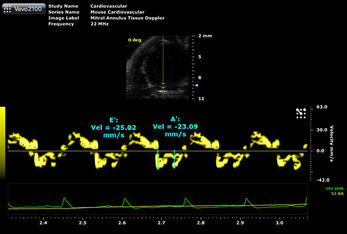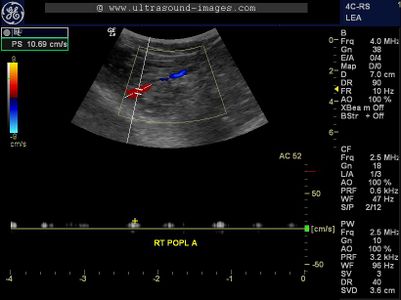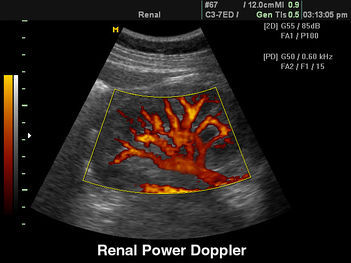Doppler sonography/types and outputs
VERY GOOD REVIEW, SOMEWHAT TOO LONG WHICH MEANS YOU MISSED AN OPPORTUNITY IN LEARNING HOW TO CHOOSE WHAT TO PUT IN AND WHAT TO LEAVE OUT, IT WOULD HAVE BEEN MORE USEFUL TO CONCENTRATE ON CERTAIN ASPECTS AND EXPLAIN THEM MORE FULLY E.G., SPECTRAL DOPPLER MODE.
|
Check of this article is requested. Suggested reviewer: Carmeljcaruana |
Types of Doppler sonography[edit | edit source]
Introduction
[edit | edit source]
All types of Doppler sonography are widely used in medicine for tissue diagnoses (especially vascular) due to it’s noninvasive nature, accessibility, high accuracy in measurements and practically no biological harmful effects. It's clinical use is rooted in 1952 when B-mode was discovered and later in 1960 when spectral mode was discovered, but it originates much earlier, in fact 1842, when Austrian physicist Christian Doppler described the "Doppler effect" in his publication: Über das farbige Licht der Doppelsterne und einiger anderer Gestirne des Himmels. Doppler sonography/physical principle is based on propagating ultrasound through tissues. Today, there are two main types (systems):
- CW - Continuous Wave system
- PW - Pulsed Wave system
And two modes which combine multiple ultrasonography elements:
- Duplex mode
- Triplex mode
Continuous wave system[1]
[edit | edit source]
CW's are from technical point of view the simplest Doppler devices. They use two crystals (lenses) as transducers - one constantly transmits ultrasound waves (usually 2 to 16 MHz in diagnostic ultrasound), the second crystal receives signal which reflects from singular erythrocytes. Furthermore, the angle between transducers is very obtuse, so overlapping of the transmitted and received beams happens in relatively big area (several centimetres, depends on the probe). The devices are cheap and relatively simple, but they have a big disadvatage - they lack axial resolution. Device measures all reflected waves from the beam's direction, therefore we can not measure blood flow velocity in deep arteries. But in hands of experienced physician, it can be a quick way how to measure arterial flow in extremities, or even measure cardiac contractions in conceptus (foetus).
Pulsed Wave system[2]
[edit | edit source]
PW's use one piezoelectric element, which alternately transmits and receives ultrasound. The probe measures the distance between a probe and a volume sample (an artery) and it is defined by the time between transmitting impulse and beginning receiving impulse. The time for how long the signal is received, determines the axial size of a volume sample, which is very useful. All of the modern sonographers use Pulse system. There is a downside to this system and that is a velocity limit of the blood flow. High velocity leads to aliasing, which is calculating error. On the other hand, precise localisation of the source of frequency shifts (flowing blood cells) in axial direction is possible.
Duplex mode[3]
[edit | edit source]
First device using this principle was assembled in 1974. This mode incorporates 2D-imaging (also known as B-mode or brightness mode or Grayscale) and Pulsed wave system. The image consists of both grey and color scale - the gray scale gives the morphological values and the color scale represents velocity values. This allows observing two elements simultaneously: morphology of the tissue (width of artery or vein) and velocity of the blood flow in it.
Triplex mode[4][edit | edit source]
An alternative of usage of the Color Doppler is Triplex mode, which combines B scan, color, and spectral Doppler mode.
The outputs of doppler sonography [5][edit | edit source]
The outputs of doppler sonography are in principle the images obtained by the doppler devices and its high frequency. That works on the basis that the high frequency ultrasound waves will reflect from the inside of the body, wherever the devices is directed at, back to its source, hence, providing an image of blood flow in the patient. Little or no preparation is needed, unless it is being done on a urgent basis. The results obtained can give valuable insight of the condition of the patient,not only in terms of blood flow.
Uses in clinical medicine [6][7][edit | edit source]
Doppler ultrasound is can be used differently, depending on the physician and what he tries to measure. Most common users of doppler ultrasonography can be cardiologists, who, as mentioned before, can use it to detect problems in the valves of the heart. Another branch of medicine which can find it useful is for instance the trauma centre, which can use it to detect disturbances in the blood flow in order to assess shock or to analyze the amount of blood loss that the patient has suffered.
The test is first initiated by taking a look at the arteries and veins of the patient. Doppler ultrasonography can be used to diagnose: arteriosclerosis of the arms and legs, which is a condition in which the patient's arteries clog up and can hardly dilate and hence the patient's extremities can be depleted of its needed oxygen and nutrients, blood clot, deep vein thrombosis and venous insufficiency, which is a condition in which the veins can hardly send blood back to the heart which results in cramping and pain standing.
Many more branches of medicine are using Doppler sonography, here are helpful links: Doppler sonography/medical applications, Fetal doppler sonography and Transcranial Doppler.
There are several types of doppler measurements, outputs.
Harmonic power doppler[edit | edit source]
Harmonic power Doppler imaging (HPDI) is a novel technique for assessing myocardial perfusion by contrast echocardiography in humans.
Tissue doppler imaging (Upper right image) [8][edit | edit source]
The tissue doppler, is using the same principles as the others but uses lower velocity to detect motions and signals in the myocardial tissue motion
Colour flow mapping (CFM) (Upper left image)[edit | edit source]
The results obtained are an array of pictues. The colour vizualization is combined with the standard ultrasound picture of blood vessels to show the speed and direction of blood through the vessels. In the image, the column bar serves as a legend which shows the velocity and direction of blood flow. The red colour indicated flow toward the transducer and blue colour indacated flow away from the transducer. If handled properly, when the transducer is aimed at an artery, the colour should be red and if it is aimed at a vein, the colour should therefore be blue. Most vessels have a laminar blood flow, which means that the velocity is higher in the middle of the vein rather than towards the border.
Spectral Imaging (Lower left image)[edit | edit source]
Is a form of ultrasound in which the DISTRIBUTION of velocities is displayed on a y-axis and time on a x-axis. Both pulse wave and continuous doppler wave are represented this way. The horizontal axis represents time while the vertical axis represents the doppler frequency.
Power doppler (Lower right image)[edit | edit source]
Power doppler is a relatively new technique which displays the strength of the doppler signal in colour rather than in speed and direction information. It has 3 times the strength of a conventional doppler and is particularly useful for small, low velocity vessels. It can be also used for showing potential areas of ischemia in the kidney, brain and prepubertal testis.
Risks
[edit | edit source]
The disadvantages could possibly be that it needs to be handled with skilled hands only in order to obtain an image, it cannot evaluate the the lungs or bowels. Doppler sonography is generally considered a very safe method of examination, even during pregnancy, the procedure is harmless. The world health organization described it as: "Diagnostic ultrasound is recognized as a safe, effective, and highly flexible imaging modality capable of providing clinically relevant information about most parts of the body in a rapid and cost-effective fashion" The question of the ethics in this field of medicine raises very few eyebrows. There is little to condemn the practice and since it is so useful to physicians, we cannot afford to lose this tool. If there are any risks, shortage of epidemiological data prevents us from finding them and the best possibility is to avoid any foreign influence on the patient's body.
Conclusion[edit | edit source]
Overall, we can conclude that the doppler sonography tool is more than useful in helping identify the problems the patient may have. It has grown rapidly in the last decade and will continue to advance as technologies improve, this includes technologies such as 3 dimensional doppler sonography which has big potential however it's best medical application is yet to be discovered.
Reference list[edit | edit source]
- ↑ Doc. MuDr. Pavel Eliáš, CSc.; Dopplerovská Ultrasonografie; Nucleus HK; 1998, ISBN 80-901753-5-X
- ↑ Viken L. Babikian, M.D.; Transcranial Doppler Ultrasonography; Mosby; 1993, ISBN 1-55664-394-2
- ↑ Prof. MUDr. Ivo Hrazdira, DrSc.; http://www.med.muni.cz/dokumenty/pdf/uvod_do_ultrasonografie1.pdf
- ↑ prof. RNDr. Evžen Amler, CSc.; https://moodle.mefanet.cz/pluginfile.php/10844/mod_resource/content/1/Acoustics_13_14.pdf
- ↑ https://en.wikipedia.org/wiki/Medical_ultrasound
- ↑ Sheldon G. Sheps, M.D.; http://www.mayoclinic.org/doppler-ultrasound/expert-answers/faq-20058452
- ↑ Mosby's Medical Dictionary; http://medical-dictionary.thefreedictionary.com/Doppler+ultrasonography
- ↑ Theodore P. Abraham; http://circ.ahajournals.org/content/116/22/2597.full






